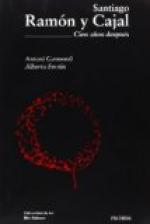|
This section contains 581 words (approx. 2 pages at 300 words per page) |

|
1852-1934
Spanish Histologist
Putting to use an interest in art that he had displayed earlier in life, Santiago Ramón y Cajal developed a method for staining individual nerve cells that improved on that developed by Italian scientist Camillo Golgi (1843-1926). For his advances in histology, a field of anatomy concerned with tissue structures and processes, Ramón y Cajal received the 1906 Nobel Prize in physiology or medicine.
Born on May 1, 1852, in a remote country village in Spain, Ramón y Cajal was the son of Justo Ramón y Casasús, a barber-surgeon, and Antonia Cajal. Despite the father's lack of money or training, he was an individual of extraordinarily strong will who managed to rise above his circumstances, obtain a medical degree, and become a professor of anatomy.
The young Ramón y Cajal was equally...
|
This section contains 581 words (approx. 2 pages at 300 words per page) |

|


